| Listing 1 - 10 of 28 | << page >> |
Sort by
|
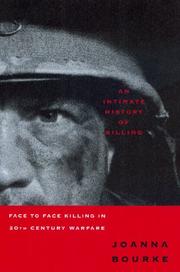
ISBN: 0465007376 0465007384 9780465007370 9780465007387 Year: 1999 Publisher: New York, N.Y. Basic Books
Abstract | Keywords | Export | Availability | Bookmark
 Loading...
Loading...Choose an application
- Reference Manager
- EndNote
- RefWorks (Direct export to RefWorks)
"The characteristic act of men at war is killing, not dying, Joanna Bourke argues. For politicians, military strategists and many historians, war may be about the conquest of territory or the struggle to recover a sense of national honor, but for the man on active service warfare is a sanctioned bloodletting." "In An Intimate History of Killing Bourke presents us with a graphic, unromanticized and chilling look at men at war, and revises many long-held beliefs about the nature of violence and the behavior of soldiers in the three great wars of this century. The two world wars and the Vietnam War bloodied the hands and consciences of thousands of British, American and Australian men and women. In this book, the combatants - men and women, soldiers, nurses and priests - share their fantasies and experiences of "intimate" killing and, in the process, reveal themselves as individuals transformed by a range of conflicting emotions: fear and ecstasy, rage and exhilaration, hatred and empathy." "What kind of men make the best killers? How do soldiers cope with the horrors they witness and the atrocities they are ordered to commit? How do soldiers readjust to "normal" civilian life? These and many other disturbing questions are answered in a series of sharply drawn chapters."--Jacket
Polemology --- anno 1900-1999 --- Combat --- Homicide --- Military history --- Psychology, Military. --- Sociology, Military. --- War. --- Psychological aspects. --- Armed Conflicts --- Guerre du Viêt-nam, 1961-1975. --- Guerre mondiale, 1914-1918. --- Guerre mondiale, 1939-1945. --- Guerre --- Oorlogvoering. --- Psychologie militaire. --- Vietnam Conflict. --- Vietnam War, 1961-1975. --- Violence --- War --- World War, 1914-1918. --- World War, 1939-1945. --- History. --- Histoire --- Psychology. --- History
Book
ISBN: 9781582436081 1582436088 Year: 2011 Publisher: Berkeley, Calif. Counterpoint
Abstract | Keywords | Export | Availability | Bookmark
 Loading...
Loading...Choose an application
- Reference Manager
- EndNote
- RefWorks (Direct export to RefWorks)
Philosophical anthropology --- Developmental psychology --- Philosophy and psychology of culture --- anno 1800-1899 --- Human beings. --- Humanism --- Human evolution. --- Psychology, Comparative. --- Human-animal relationships. --- Equality. --- History.
Book
ISBN: 9780199689422 9780191003547 0199689423 0191003549 9781306549226 1306549221 0191003557 Year: 2014 Publisher: Oxford Oxford University Press
Abstract | Keywords | Export | Availability | Bookmark
 Loading...
Loading...Choose an application
- Reference Manager
- EndNote
- RefWorks (Direct export to RefWorks)
Everyone knows what is feels like to be in pain. Scraped knees, toothaches, migraines, giving birth, cancer, heart attacks, and heartaches: pain permeates our entire lives. We also witness other people - loved ones - suffering, and we 'feel with' them. It is easy to assume this is the end of the story: 'pain-is-pain-is-pain', and that is all there is to say. But it is not. In fact, the way in which people respond to what they describe as 'painful' has changed considerably over time. In the eighteenth and nineteenth centuries, for example, people believed that pain served a specific (and positi
Pain --- Pain Management --- English language --- Douleur --- Anglais (Langue) --- history --- Psychological aspects. --- Aspect psychologique --- Histoire --- Aspect physiologique --- Thérapeutique --- Affective and dynamic functions --- Philosophical anthropology --- History of civilization --- History of human medicine --- anno 2000-2009 --- anno 1900-1999 --- anno 1700-1799 --- anno 1800-1899 --- anno 2010-2019 --- United Kingdom --- Religious studies --- anno 1800-1999 --- anno 2000-2099 --- history. --- Histoire. --- Germanic languages
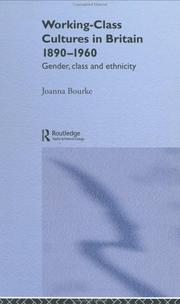
ISBN: 0415098971 041509898X 9780415098984 9780415098977 Year: 2010 Publisher: London Routledge
Abstract | Keywords | Export | Availability | Bookmark
 Loading...
Loading...Choose an application
- Reference Manager
- EndNote
- RefWorks (Direct export to RefWorks)
History of the United Kingdom and Ireland --- anno 1800-1999 --- 316.343.63 <41> --- Arbeidersstand. Proletariaat. Landarbeiders --(sociale stratificatie)--Verenigd Koninkrijk van Groot-Brittannië en Noord-Ierland --- 316.343.63 <41> Arbeidersstand. Proletariaat. Landarbeiders --(sociale stratificatie)--Verenigd Koninkrijk van Groot-Brittannië en Noord-Ierland --- Sex role --- Working class --- #SBIB:316.7C130 --- #SBIB:HIVA --- Gender role --- Sex (Psychology) --- Sex differences (Psychology) --- Social role --- Gender expression --- Sexism --- History --- Groepscultuur en subculturen --- Great Britain --- Social conditions --- History. --- 20th century --- 19th century --- Working class - Great Britain - History. --- Sex role - Great Britain - History. --- Gender roles --- Gendered role --- Gendered roles --- Role, Gender --- Role, Gendered --- Role, Sex --- Roles, Gender --- Roles, Gendered --- Roles, Sex --- Sex roles
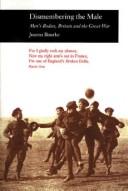
ISBN: 0948462825 1861890354 Year: 1996 Publisher: London Reaktion books
Abstract | Keywords | Export | Availability | Bookmark
 Loading...
Loading...Choose an application
- Reference Manager
- EndNote
- RefWorks (Direct export to RefWorks)
Men --- -Body, Human --- -Sociology of disability --- -World War, 1914-1918 --- -Masculinity --- -European War, 1914-1918 --- First World War, 1914-1918 --- Great War, 1914-1918 --- World War 1, 1914-1918 --- World War I, 1914-1918 --- World War One, 1914-1918 --- WW I (World War, 1914-1918) --- WWI (World War, 1914-1918) --- Masculinity (Psychology) --- Disabilities --- Sociology of disablement --- Sociology of impairment --- Body, Human --- Human males --- Social aspects --- -Social aspects --- -Sociological aspects --- History, Modern --- Sex (Psychology) --- People with disabilities --- Human beings --- Body image --- Human anatomy --- Human physiology --- Mind and body --- Males --- Effeminacy --- Masculinity --- Human body --- Sociology of disability --- World War, 1914-1918 --- Corps humain --- Masculinité --- Hommes --- Handicap --- Première guerre mondiale --- History --- Aspect social --- Histoire --- Aspect sociologique --- Great Britain --- Grande-Bretagne --- -Masculinity (Psychology) --- European War, 1914-1918 --- -Human body --- -Men --- -Social aspects -
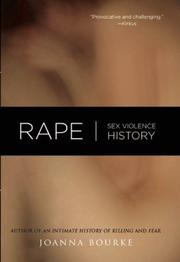
ISBN: 9781593761141 1593761147 Year: 2007 Publisher: [London] Shoemaker Hoard
Abstract | Keywords | Export | Availability | Bookmark
 Loading...
Loading...Choose an application
- Reference Manager
- EndNote
- RefWorks (Direct export to RefWorks)
History of the law --- Criminology. Victimology --- Rape --- Sociology of the family. Sociology of sexuality --- Criminal law. Criminal procedure --- Sexology --- Feminism --- Sexuality --- Sexually transgressive behavior --- Criminal law --- Book --- Criminality --- Perpetrators
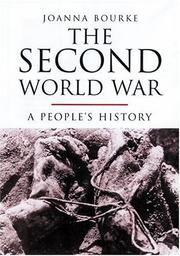
ISBN: 1280444509 1423767578 9781423767572 9780192802248 0192802240 9781280444500 9786610444502 6610444501 Year: 2001 Publisher: Oxford New York Oxford University Press
Abstract | Keywords | Export | Availability | Bookmark
 Loading...
Loading...Choose an application
- Reference Manager
- EndNote
- RefWorks (Direct export to RefWorks)
World War II surpassed all previous wars in the sheer cost of many millions of lives, most of them civilian. It left a world reeling from physical destruction on a scale never experienced till then, and from the psychological traumas of loss, of imprisonment and genocide, and permanent exile from home.; In this work, Joanna Bourke examines the events and outcomes in the vast number of places in which the War was fought: throughout Western and Central Europe, on the Eastern Front in the Soviet Union, in the Pacific, in Africa, in Asia. She shows where the strategic decisions came from and how they were implemented, but she also shows, through diary entries and recorded oral history, how ordinary people felt when they witnessed or heard of events, from the declaration of war on the radio to the mass murders carried out by Nazi soldiers in Russian villages.
World War, 1939-1945. --- World War, 1939-1945 --- History - General --- History & Archaeology --- European War, 1939-1945 --- Second World War, 1939-1945 --- World War 2, 1939-1945 --- World War II, 1939-1945 --- World War Two, 1939-1945 --- WW II (World War, 1939-1945) --- WWII (World War, 1939-1945) --- History, Modern
Book
ISBN: 9781780238463 1780238460 Year: 2017 Publisher: London Reaktion Books
Abstract | Keywords | Export | Availability | Bookmark
 Loading...
Loading...Choose an application
- Reference Manager
- EndNote
- RefWorks (Direct export to RefWorks)
In times of crisis, we often turn to artists for truth-telling and memory-keeping. There is no greater crisis than war, and in this sumptuously illustrated volume, we find a comprehensive visual, cultural, and historical account of the ways in which armed conflict has been represented by artists.Covering the last two centuries, from the Crimean War to the present day, the book shows how the artistic portrayal of war has changed, from a celebration of heroic exploits to a more modern, troubled, and perhaps truthful depiction of warfare and its consequences. The book investigates broad patterns as well as specific genres and themes of war art, and features more than 400 color illustrations by artists including Paul Nash, Judy Chicago, Pablo Picasso, Melanie Friend, Marc Chagall, Francis Bacon, Käthe Kollwitz, Joseph Beuys, Yves Klein, Robert Rauschenberg, Dora Meeson, Otto Dix, and many others. The volume also highlights the work of often overlooked artists, including children, non-Europeans, and prisoners of war. A wide range of subjects, from front-line combat to behind-the-lines wartime experiences are represented in paintings, etchings, photography, film, digital art, comics, and graffiti.Edited and with an introduction by Joanna Bourke, War and Art features essays written by premier experts in the field. This extensive survey is a fitting and timely contribution to our understanding of art, memory, and commemoration of war.
War in art. --- Art and war. --- Art, Modern --- Dix, Otto 1891-1969 (°Gera, Duitsland) --- Kollwitz, Käthe 1867-1945 (°Königsberg, Oost-Pruisen, nu Kaliningrad, Rusland) --- Spero, Nancy 1926-2009 (°Cleveland, Ohio, Verenigde Staten) --- Landschapsschilderkunst ; geschiedenis ; slagvelden --- Thema's in de kunst ; oorlog --- Architectuur ; herinneringsruimten van de oorlog --- Kunst en politiek ; kunst en oorlog --- Kunsttheorie ; oorlog en trauma in de kunst --- Thema's in de grafiek ; oorlog --- 7.044 --- Iconografie ; historische voorstellingen
Book
ISBN: 0192846639 9780192846631 Year: 2022 Publisher: Oxford Oxford university press
Abstract | Keywords | Export | Availability | Bookmark
 Loading...
Loading...Choose an application
- Reference Manager
- EndNote
- RefWorks (Direct export to RefWorks)
"In 2023, Birkbeck, University of London celebrates 200 years of educating working people in central London. It was founded in 1923 as the London Mechanics' Institution and, from its inception, was a pioneering and radical institution. This history is animated by the conviction that Birkbeck is its people. Their thoughts and ambitions, hopes and dreams, labour and laughter are what this book describes, celebrates, and occasionally laments. It explores the history of education as well as the history of place, politics, radicalism, class, race, gender, disciplinarity, theatre, food, leisure, war, and everyday encounters. Most of all, this book is about ideas. What does it mean to be educated? How have these meanings changed over time? What makes Birkbeck students unique? What does it mean to be fully human, exploiting our faculties in order to become better people?"--
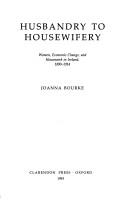
ISBN: 0198203853 Year: 1993 Publisher: Oxford : Clarendon press,
Abstract | Keywords | Export | Availability | Bookmark
 Loading...
Loading...Choose an application
- Reference Manager
- EndNote
- RefWorks (Direct export to RefWorks)
Housewives --- Women --- History. --- Employment
| Listing 1 - 10 of 28 | << page >> |
Sort by
|

 Search
Search Feedback
Feedback About UniCat
About UniCat  Help
Help News
News